SIBERIAN PINE, PINUS SIBIRICA OR ANCIENT NATIVE NAME "SIBERIAN CEDAR"
Cedar Nut Oil and Its Uses

Pine nut oil is an unusually valuable natural product obtained from the seeds of Siberian cedar cones. It is noteworthy that to get 1 kilogram of this useful product, you need to process 3 kilograms of raw nuts. But this oil pressed from Siberian cedar seeds is a storehouse of vitamins, microelements and other useful components.
The oldest relict tree - cedar, gives people valuable wood, delicious nuts, and healing oil.
The history of cedar nut oil goes back several centuries back. In Siberia, it used to be obtained by a handicraft method - people grounded the peeled cedar kernels in mortars, put the mixture in special vats with troughs and poured hot water. On heating, an oily liquid was released, which was drained through the chute. Factory production of cedar nut oil began in Russia from the middle of the 19th century. The product has been widely used in cooking.
The inhabitants of Siberia prepared "cedar milk" and "vegetable cream" from cedar nuts. The kernels were removed from the dried nuts, they were additionally dried and peeled from the film. Dry kernels were pounded in wooden mortars, adding a little of hot water. The resulting mushy mass was poured into a cast iron or earthen pot and brought to a boil in a Russian oven, and the cream was ready. Before consuming, boiled water was added to the cream and cedar milk was obtained.
The most valuable cedar nut oil is the first pressed cedar nut oil, which is pressed on wooden presses out of raw nuts. Cold pressed cedar nut oil has a beautiful light amber color and a pleasant nutty smell. In terms of taste, it is not inferior to the best varieties of olive and almond oils.
These articles come directly from researchers and are passed on to everybody. CedarNutOil.org assumes no liability for any content in these articles.
For Educational purposes only.
This information has not been evaluated by the Food and Drug Administration.
This information is not intended to diagnose, treat, cure, or prevent any disease.
Facts about Cedar

Druids, the ancient Celtic priests, possessed deep knowledge about the nature of trees and their connection with man and the Universe. The cedar was one of a number of “healing trees” they identified. The cedar’s special properties were noted by several races in the Bible. Thus, in Leviticus, the third book of Moses, God teaches priests to heal people. Of all the plants, only cedar is mentioned several times as a healing and cleansing tree (a cure for leprosy, among others).
* * *
The legend concerning the cedar states that:
The Mother of the World said to the Creator: “Sparks from the Fire of your Spirit can bring salvation, but who will gather them, who will keep them?" And the Creator replied: “The trees and grass will keep my sparks, but when the sparks fall let the Cedar and its sisters keep their elements of Fire for the whole year." (A. Klizovsky, The Fundamental Principles of Understanding the World in the New Era, volume 3).
* * *
Cedar Nut Oil proteins contain 19 amino acids, of which 70% are vital. Vitamins in the oil help the human body to grow (vitamin A). They stabilize the central nervous system, improve blood composition and favorably affect skin tissue (vitamins B and D). The oil is very rich in vitamin E (tocopherol - from the Greek for "bearing offspring"). Studies have shown that sables are unable to reproduce if their ration does not include cedar nuts. The Cedar Nut Oil is very rich in vitamin P: it contains three times as much vitamin P as the product called "Vitamin P" made using fish oil. Vitamin P is made up of vital fatty acids, which help to reduce the level of cholesterol in your bloodstream and prevent the formation of plaques on the walls of blood vessels.
http://www.ringingcedarsofrussia.org/
Used by permition
Copyright http://www.CedarInfo.info/
These articles come directly from researchers and are passed on to everybody. CedarNutOil.org assumes no liability for any content in these articles.
For Educational purposes only.
This information has not been evaluated by the Food and Drug Administration.
This information is not intended to diagnose, treat, cure, or prevent any disease.





